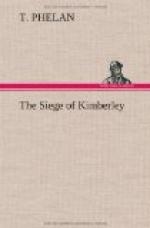We were startled from our slumbers at an early hour on Saturday morning by the booming of artillery and a succession of very distinct explosions. The shells fell broadcast, and whistled—while we sought vainly to see them—with a disconcerting whiz above our heads. Their contact with mother earth resulted in a loud crash; it was hard to believe that the theorist who opined that the Boers had “forgotten the powder” (before) was a clever fellow. They had remembered it this time; its odour was everywhere. It was our first real taste of a bombardment, and a nauseating taste it proved. Men and women had a vague belief that hundreds must be dead. Consternation reigned; and when it was reported that a woman had been killed in Dutoitspan Road, the excitement was at its height. The fatality sent a thrill of horror through the people, who awaited in dread anticipation the news of further massacres. The victim was a poor washerwoman, and the possibilities it conjured up before the mind’s eye made her death doubly unfortunate. But, happily, no further damage to life or limb was to be recorded. A good many houses were hit, though not injured materially. A shell entered the Gresham Bar, and it was surprising that so few glasses should have been smashed; more marvellous still that the fair bar-tender should have remained fair; she was merely frightened. As for the proprietor, he held up fairly well. There was a hole in his roof (I don’t mean his head), but he made the price of a decent patch in ten minutes. The men about town flocked in to have a laugh at the mess, and were amazed to find a bottle intact, or a bigger utensil to drink from than a “thimble” indeed.
Feeling against the Boers grew strong. Enquiries about the British troops, their movements, their dilatoriness, were sternly renewed; it was reckoned time to “clear the border.” That Colonel Kekewich was angry goes without saying; he despatched two mounted forces in opposite directions to record a general protest. One of these, led by Colonel Scott-Turner, rode towards Otto’s Kopje. The enemy, however, were apparently prepared for Turner; they opened fire with a gun, and endeavoured to cut him off. In this they failed; they drew rather too near, and so far from intimidating the fighting Colonel, enabled him to register his protest very forcibly. Nine Boers were shot down; three on the British side were injured. Meanwhile the force under Major Peakman was protesting at Carter’s Farm. The enemy there made a bold effort to silence Peakman. But a Maxim gun has a remarkable gift of the gab; the Major had one with him, and he let it do all the talking—with results that quickly drove the Boers beyond the range of its Phillipics.
Notwithstanding these castigations, or perhaps because of them, the bombardment was resumed in the afternoon. Wesselton was assailed; a few shells also fell into Kimberley, with no serious consequences. Silence reigned at six o’clock. It was an exciting finale to the week. The morrow would be Sunday, and glad we were to hear it. And still relief was deferred; but the troops were at Orange River, and seventy miles, they told us, was a trifle in darkest Africa. That they (the troops) would soon arrive did not admit of a doubt. And then?—and then the Boer would run away or die.




